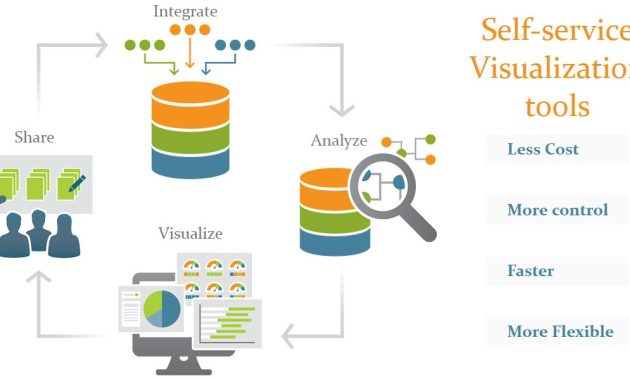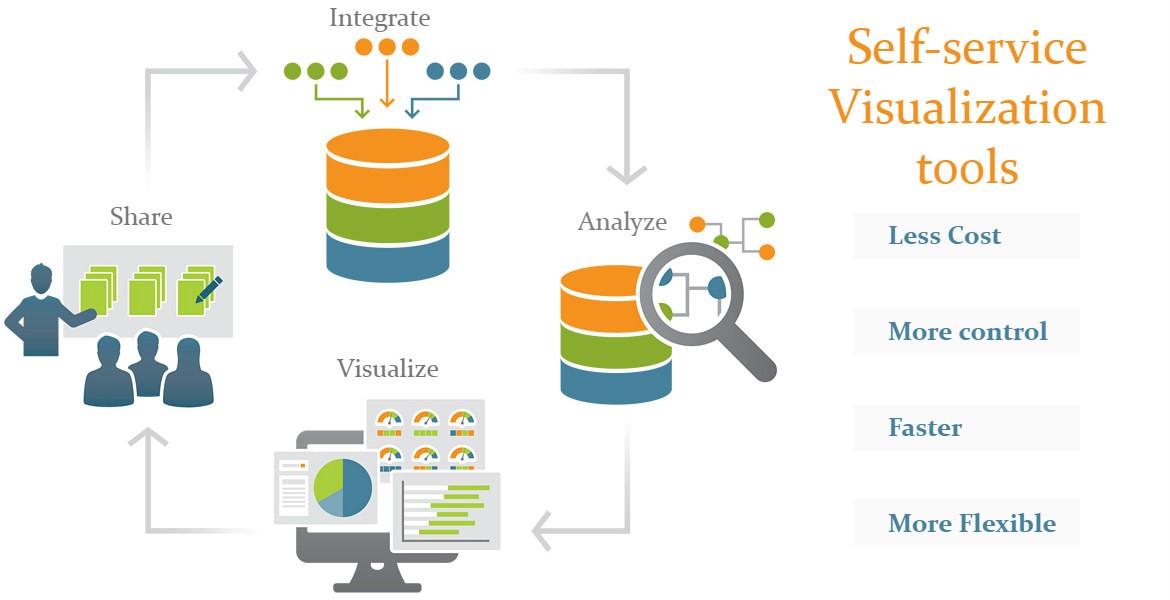
Self-Service Business Intelligence Software: A New Era of Data Accessibility
In today’s fast-paced business environment, the ability to make informed decisions quickly is paramount. The rise of self-service business intelligence software has revolutionized how organizations access and utilize data. No longer are insights locked away in the hands of a select few. Now, employees across various departments can analyze data, create reports, and make decisions based on clear, actionable information. This shift empowers individuals and accelerates the overall decision-making process, leading to greater agility and competitiveness.
The core principle behind self-service business intelligence software is to provide users with the tools they need to explore data independently. This contrasts with traditional business intelligence (BI) models where IT departments or specialized analysts were responsible for data extraction, transformation, and reporting. With self-service BI, the focus shifts to user empowerment, enabling them to directly engage with data and derive insights relevant to their roles and responsibilities.
Understanding the Core Functionality of Self-Service BI
At its heart, self-service business intelligence software is designed to simplify the data analysis process. It achieves this through several key functionalities:
- Data Connectivity: The ability to connect to various data sources, including databases, spreadsheets, cloud platforms, and more. This allows users to pull data from diverse locations into a single, unified view.
- Data Preparation: Tools for cleaning, transforming, and shaping data to ensure accuracy and consistency. This might involve removing duplicates, correcting errors, or aggregating data for analysis.
- Data Visualization: Intuitive and interactive dashboards and reports that present data in a clear, easily understandable format. These visualizations often include charts, graphs, maps, and other visual elements.
- Data Analysis: Capabilities for performing various types of analysis, such as filtering, sorting, grouping, and calculating key metrics. This allows users to explore data, identify trends, and uncover insights.
- Collaboration and Sharing: Features that enable users to share their findings with colleagues, collaborate on reports, and disseminate insights across the organization.
The Benefits of Implementing Self-Service Business Intelligence Software
The adoption of self-service business intelligence software offers a multitude of benefits to organizations of all sizes:
- Faster Decision-Making: By providing immediate access to data and insights, self-service BI enables quicker decision-making. Users can analyze data in real-time and make informed choices without waiting for reports from IT or analysts.
- Improved Data Literacy: Self-service BI tools often come with training and support resources, helping to improve data literacy across the organization. This leads to a greater understanding of data and its importance in decision-making.
- Reduced Reliance on IT: By empowering users to analyze data independently, self-service BI reduces the burden on IT departments. This allows IT staff to focus on more strategic initiatives.
- Increased Agility and Responsiveness: The ability to quickly analyze data and identify trends allows organizations to adapt to changing market conditions and respond to opportunities more effectively.
- Enhanced Collaboration: Self-service BI platforms often include features that facilitate collaboration and sharing of insights. This promotes communication and knowledge sharing across departments.
- Cost Savings: By streamlining the data analysis process and reducing the need for specialized analysts, self-service BI can lead to significant cost savings.
Key Features to Look for in Self-Service Business Intelligence Software with Clear Views
Choosing the right self-service business intelligence software is crucial for success. Several key features should be considered when evaluating different solutions:
- User-Friendly Interface: The software should have an intuitive and easy-to-use interface, allowing users of all skill levels to navigate and analyze data.
- Data Visualization Capabilities: The platform should offer a wide range of visualization options, including charts, graphs, maps, and dashboards, to present data in a clear and compelling way.
- Data Connectivity: The software should be able to connect to a variety of data sources, including databases, spreadsheets, and cloud platforms.
- Data Preparation Tools: The platform should provide tools for cleaning, transforming, and shaping data to ensure accuracy and consistency.
- Mobile Access: The ability to access and analyze data on mobile devices is essential for staying informed on the go.
- Collaboration Features: The platform should offer features that facilitate collaboration and sharing of insights, such as commenting, annotations, and report sharing.
- Security and Governance: Robust security features are essential to protect sensitive data. The platform should also provide governance capabilities to ensure data accuracy and compliance.
- Scalability: The software should be able to handle growing data volumes and user demands as the organization grows.
Selecting the Right Self-Service BI Solution
The selection process should involve a thorough evaluation of the organization’s needs and requirements. Consider these steps:
- Assess Needs: Identify the specific data analysis needs of different departments and user groups.
- Evaluate Options: Research and compare different self-service business intelligence software solutions, considering their features, pricing, and ease of use.
- Pilot Testing: Conduct a pilot test with a small group of users to evaluate the software’s functionality and usability.
- Training and Support: Ensure that adequate training and support resources are available to help users get the most out of the software.
- Implementation and Deployment: Plan the implementation and deployment process carefully, taking into account data migration, user training, and system integration.
The Impact of Clear Views in Self-Service BI
One of the most critical aspects of effective self-service business intelligence software is the ability to provide clear views of the data. This means presenting information in a way that is easy to understand, actionable, and relevant to the user’s needs. This is achieved through:
- Intuitive Dashboards: Dashboards should be designed with a clear layout, using visual elements like charts and graphs to highlight key metrics and trends.
- Interactive Reports: Reports should allow users to drill down into the data, filter information, and explore different perspectives.
- Data Storytelling: The ability to present data in a narrative format, using visualizations and annotations to explain the context and significance of the insights.
- Customization: Users should be able to customize their dashboards and reports to focus on the information that is most relevant to their roles.
Clear views are essential for ensuring that users can quickly and easily understand the data and make informed decisions. Without clear and concise presentation, the data becomes meaningless and the value of the self-service business intelligence software is diminished.
Future Trends in Self-Service Business Intelligence
The self-service business intelligence landscape is constantly evolving. Several trends are shaping the future of this technology:
- Artificial Intelligence (AI) and Machine Learning (ML): AI and ML are being integrated into self-service BI platforms to automate tasks, provide predictive analytics, and offer insights that might not be apparent through traditional analysis.
- Natural Language Processing (NLP): NLP is enabling users to interact with data using natural language queries, making it easier to access and analyze information.
- Cloud-Based BI: Cloud-based self-service BI platforms are becoming increasingly popular due to their scalability, flexibility, and cost-effectiveness.
- Embedded BI: BI capabilities are being embedded into other applications, allowing users to access insights within the context of their daily workflows.
- Data Governance and Security: Increased focus on data governance and security to ensure data accuracy, compliance, and protection.
These trends are poised to further enhance the capabilities of self-service business intelligence software, making it even more powerful and accessible for organizations of all sizes.
Conclusion: Embracing the Power of Data with Self-Service BI
Self-service business intelligence software is a transformative technology that empowers organizations to make data-driven decisions with greater speed, agility, and effectiveness. By providing users with the tools they need to access, analyze, and visualize data, self-service BI fosters a culture of data literacy and empowers employees across all departments. With the right self-service business intelligence software and a focus on clear views, organizations can unlock the full potential of their data and gain a competitive advantage in today’s dynamic business environment.
The adoption of self-service business intelligence software is no longer a luxury, but a necessity for organizations seeking to thrive in the modern data-driven world. By embracing this technology and investing in the right tools and training, businesses can empower their employees, improve decision-making, and achieve greater success.
[See also: Choosing the Best BI Tool for Your Business, Data Visualization Best Practices, The Future of Business Intelligence]

